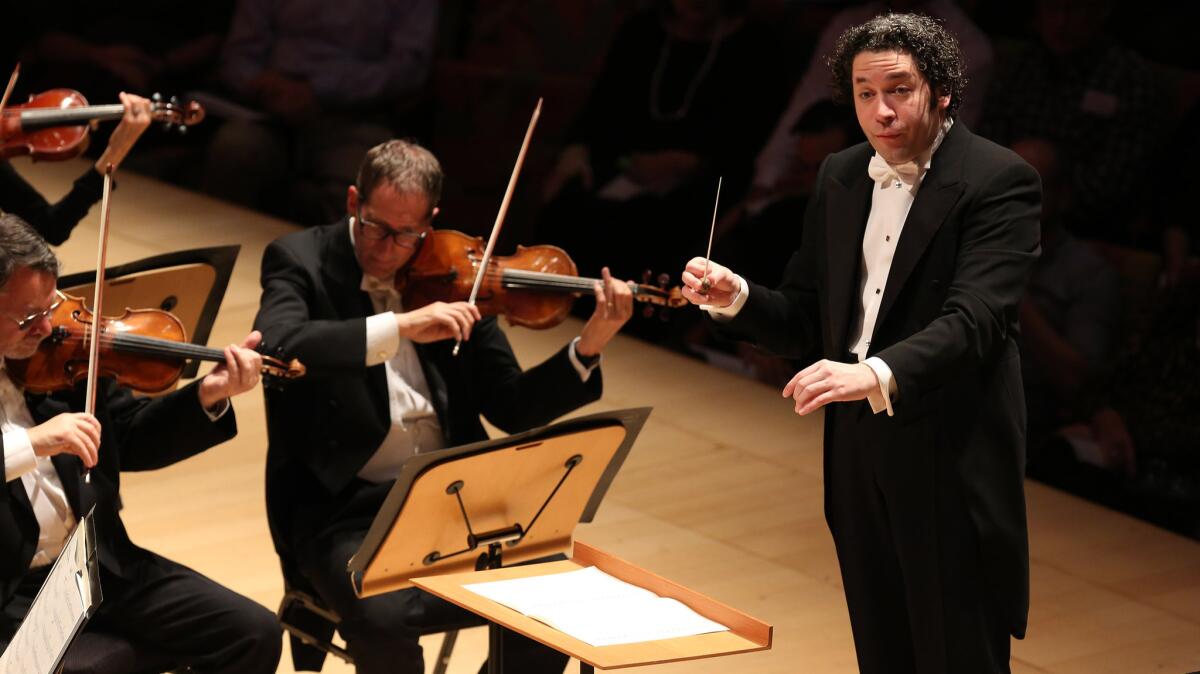Review: Dudamel leads a dark and satisfying dose of Mozart and Pärt

- Share via
Each of the programs in Gustavo Dudamel’s Mozart & Pärt mini-festival at Walt Disney Concert Hall had a title designed to give listeners a fair idea of what to expect. The first program was entitled “Requiem and Miserere,” the second was simply “The Angels.” The third on Saturday afternoon promised a world premiere — not from Mozart, of course, but from the very-much-alive Arvo Pärt, who was on hand to listen, take a bow and sign CDs afterward.
Pärt’s contribution, a Los Angeles Philharmonic commission, was actually a bit less than what the words “world premiere” usually indicate. It was a string orchestra arrangement of a piece called “Seven Magnificat Antiphons” for a cappella chorus that has existed since 1988, now retitled “Greater Antiphons” in the string version.
As companions for Pärt, Dudamel chose the Mozart Symphonies Nos. 25 and 40 — the only Mozart symphonies that are written in a minor key, and the same G minor key at that. With the Pärt piece forming the middle of a Mozart G-minor sandwich, Dudamel the ever-creative programmer came up with a unified, dark-shaded lineup.
About 15 minutes, “Greater Antiphons” tracks the choral version pretty closely and is divided into seven sections: Wisdom, Adonai, Root of Jesse, Key of David, Morning Star, King of All People and Emmanuel. Pärt ’s idiom here is what you would expect from this composer — solemn, unhurried, evoking the Renaissance and the minimalists but with a radiance all his own.
Hearing “Greater Antiphons” in this new version, some impressions remain the same as in the choral original, while other perspectives change considerably. The haunting high soprano harmony in “O Wisdom” is now taken by the violins. The fourth section is inflated into a massive wash of anguish that feels surprisingly peaceful at the same time. The dissonances underneath some of the uplifting simple affirmative chords add an increased tension in the string version.
I can imagine this piece being even more effective if it were played in a highly reverberant space — say, a cathedral or perhaps the string-friendly Soka Performing Arts Center in Aliso Viejo — where the chords before the frequent pauses in the score would decay ethereally into the room. In any case, Dudamel was able to conjure a warm, broad, bassy string sound in Disney Hall that had its own virtues.
Both of the Mozart symphonies were treated to full-blooded symphonic performances, nothing precious or period-performance-obsessed. But beyond that, it was no contest as to which of them came off more convincingly. While the Symphony No. 25 seemed rather routine and restrained, everything came alive in the Symphony No. 40. The L.A. Phil’s playing was more animated and together, more passionate and emotional. The textures were clearer, every tempo was centered comfortably around the middle of the spectrum. It was one of the most satisfying Mozart 40s in many a year.
For those who keep score, the concert contained only a little more than an hour of music — at premium prices.
Follow The Times’ arts team @culturemonster.
More to Read
The biggest entertainment stories
Get our big stories about Hollywood, film, television, music, arts, culture and more right in your inbox as soon as they publish.
You may occasionally receive promotional content from the Los Angeles Times.










